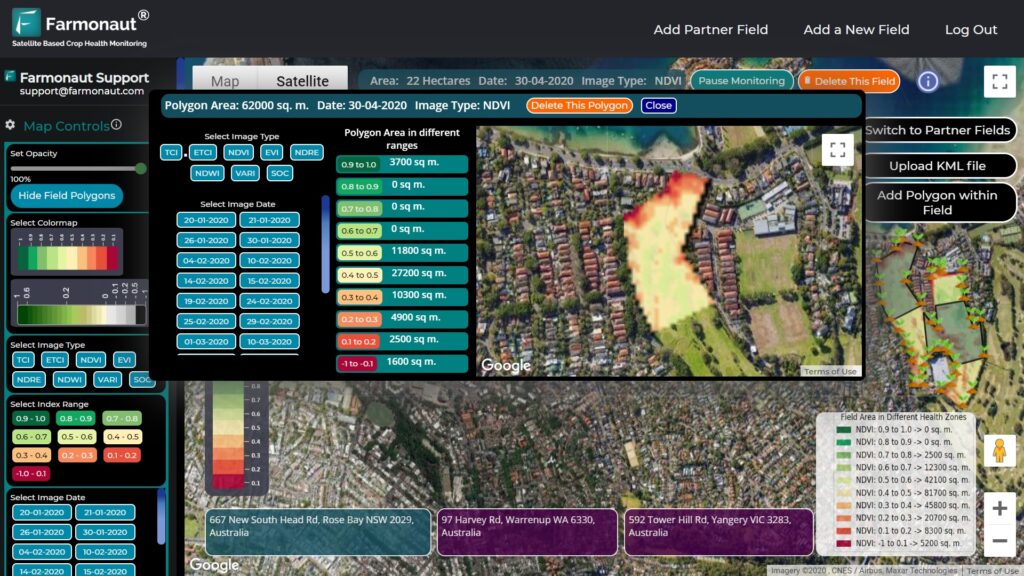Magnesium Deficiency Plants: 7 Secret Fixes Exposed!
“Up to 30% yield loss in crops can occur due to magnesium deficiency if left unmanaged.”
Table of Contents
- The Crucial Role of Magnesium in Plant Health
- Understanding Magnesium Deficiency Causes
- Identifying Magnesium Deficiency Symptoms in Plants
- Plant Nutrient Deficiencies Diagnosis: Distinguishing Magnesium Issues
- 7 Secret Fixes for Magnesium Deficiency in Plants
- Symptom-Fix-Impact Table
- Farmonaut’s Satellite Tools for Better Magnesium Management
- Improving Soil Magnesium Availability and Sustainable Strategies
- FAQ: Magnesium Deficiency in Plants
- Conclusion & Empowering Sustainable Agriculture
As we advance sustainable agricultural practices, magnesium deficiency in plants emerges as a significant challenge that can greatly affect crop yields, soil health, and the long-term success of our farming systems. Understanding, detecting, and managing magnesium deficiencies is not only crucial for crop production but also essential for the overall sustainability and resilience of our agricultural ecosystems.
In this comprehensive guide, we will delve deep into the role of magnesium, explore how its deficiency impacts plant growth, reveal seven secret fixes to address these symptoms, and showcase the power of modern technologies, like those offered by Farmonaut, to optimize nutrient management for healthier, higher-yielding crops.
1. The Crucial Role of Magnesium in Plant Health
Magnesium (Mg), as a critical macronutrient in plant physiology, is at the heart of nearly all biological processes that drive plant vitality, growth, and resilience. Let’s highlight why magnesium is central to our crops’ health:
- Central Atom in Chlorophyll: Magnesium is the core of the chlorophyll pigment, enabling plants to capture light energy for photosynthesis. Without sufficient magnesium, plants cannot effectively produce carbohydrates, proteins, and fats, leading to stunted growth and low yields.
- Enzyme Activation & Energy Transfer: Over 300 enzymes involved in crucial biochemical processes, including ATP (energy) transfer and nucleic acid synthesis, rely on magnesium for activation. This supports efficient protein synthesis and cellular metabolism.
- Structural Stability & Nutrient Transport: Magnesium helps in stabilizing ribosome structures (essential for protein creation) and aids the transport of phosphorus within the plant, further enhancing growth and overall plant health.
As we see, monitoring and maintaining adequate magnesium in soil is non-negotiable for healthy crops and productive soils.
2. Understanding Magnesium Deficiency Causes in Plants
Magnesium deficiency can stealthily undermine even the most well-managed cropping systems. Let’s explore the key magnesium deficiency causes that every farmer and grower should know:
- Soil Composition & pH: Acidic, sandy, and coarse-textured soils with low cation exchange capacity (CEC) are especially vulnerable. Here, magnesium ions are easily leached away, reducing availability of this vital nutrient for plant uptake.
- High Calcium Levels: Soils with excessive calcium can displace magnesium on exchange sites, leading to reduced magnesium uptake and deficiency symptoms in plants.
- Intensive Cropping & Continuous Systems: Farms with intensive cropping often remove large amounts of magnesium without proper replenishment or returning crop residues, slowly depleting soil reserves over time.
- High Nitrogen Fertilization: Rapid vegetative growth spurred by excess nitrogen increases magnesium demand. If not matched with sufficient magnesium supply, visible deficiency arises.
Understanding the magnesium deficiency causes equips us with the skills to proactively address issues and improve soil magnesium availability.
3. Identifying Magnesium Deficiency Symptoms in Plants
Successful magnesium deficiency management strategies begin with keen observation. What should we look for? Magnesium deficiency symptoms are often most apparent on the older leaves, due to magnesium’s mobility within the plant:
- Interveinal Chlorosis in Plants: Older leaves exhibit distinctive yellowing between veins (interveinal chlorosis), with veins remaining green. This classic symptom helps differentiate magnesium shortage from other deficiencies.
- Necrotic Lesions: Severe magnesium shortage causes brown, dead spots (necrotic lesions) at the edges of older leaves, potentially leading to premature leaf drop.
- Stunted Growth: Reduced growth, smaller overall plants, and lower yields often develop due to impaired photosynthesis and insufficient enzyme function.
- Leaf Curling: Older leaves may curl upward or downward as magnesium shortage intensifies.
If these symptoms are present, a swift response is crucial to maintain crop quality and productivity.
4. Plant Nutrient Deficiencies Diagnosis: Distinguishing Magnesium Issues
Accurate diagnosis is essential. Many plant deficiencies can cause yellowing or browning of leaves, so how do we confirm that magnesium is the culprit? Here’s how magnesium deficiency symptoms compare to other common issues:
- Potassium Deficiency: Like magnesium, affects older leaves, but potassium-deficient leaves show marginal scorching (dead tissue on leaf edges) rather than the interveinal chlorosis characteristic of magnesium shortage.
- Nitrogen Deficiency: Also causes leaf yellowing, but chlorosis is typically uniform rather than interveinal.
- Waterlogging: Can turn older leaves yellow, but lacks the clear pattern of interveinal chlorosis and necrotic lesions seen in magnesium-deficient plants.
When in doubt, soil and tissue testing (see fixes below!) fortifies our ability to distinguish between these deficiencies and tailor solutions precisely.
Modern technologies play a pivotal role in improving nutrient diagnostics. Farmonaut’s API (explore here) lets agronomists, tech companies, and researchers access satellite and weather-driven farm data—including vegetation health and potential signs of nutrient stress. For integration details, see the latest developer documentation.
“Magnesium deficiency affects over 20% of global agricultural soils, impacting plant health and sustainability.”
5. 7 Secret Fixes for Magnesium Deficiency in Plants
Let’s unveil the science-backed, field-tested interventions that can transform magnesium-deficient plants into vibrant, productive ones. These magnesium deficiency management strategies are the keys to higher yield and resilient agriculture.
-
Soil Testing: The Foundation of Smart Magnesium Fixes
Regular soil testing identifies magnesium availability in soil and guides us toward appropriate fertilization. It helps prevent both deficiency and unnecessary oversupply—two sides of effective nutrient management. Utilize accurate soil analysis before planting, after harvest, and during critical points in crop rotation.
-
Magnesium Fertilization for Crops
Applying magnesium fertilizers (such as magnesium sulfate – Epsom salt) directly addresses deficiency, either as soil amendments or foliar sprays. Foliar sprays act rapidly, providing relief in acute situations, while soil application ensures long-term magnesium supply to developing crops.
-
Organic Amendments & Compost
Improving soil structure and enhancing cation exchange capacity with well-decomposed compost or organic matter boosts magnesium’s retention in soil, making it more available to crops—especially in sandy or low-CEC soils.
-
Soil pH Management: Fighting Acidity
Acidic soils are notorious for magnesium leaching. Applying dolomitic lime not only neutralizes soil acidity but also supplies essential magnesium to plants—a double win for nutritional balance.
-
Crop Selection & Rotation for Sustainability
Selecting crops that are efficient in magnesium uptake, or rotate with cover crops that help stabilize magnesium levels, reduces depletion risks. This is especially vital in intensive cropping systems on marginal soils.
-
Efficient Irrigation Management
Over-irrigation and poor drainage lead to leaching—a frequent cause of magnesium deficiency. Utilize precision irrigation tools and monitoring to align water applications with plant demand, preserving magnesium and all vital nutrients.
-
Farmonaut’s Satellite-Based Advisory for Proactive Control
While classic interventions treat the root cause, today’s precision farming allows for real-time monitoring of magnesium and other stresses. Farmonaut’s satellite-powered platform delivers regular updates on crop health, identifying early signs of stress before symptoms are visible. This enables timely, targeted interventions, reduces fertilizer wastage, and sustains yields for large and small farms alike.
Learn more about large scale farm management tools here, designed to make advanced crop monitoring accessible at scale.
6. Symptom-Fix-Impact Table: Quick Guide to Addressing Magnesium Deficiency
Use this table as a rapid reference for actionable magnesium deficiency management strategies and yield impact assessment.
7. Farmonaut’s Satellite Tools for Better Magnesium Management
Harnessing precision agriculture for sustainable farming means leveraging data. That’s where Farmonaut steps in with its satellite-based crop health monitoring and AI-powered advisory services. Here’s how our satellite and mobile-based platform can revolutionize nutrient management:
- Real-time crop monitoring: Want to detect early signs of stress—possibly from magnesium deficiency, water shortages, or disease? Our platform visualizes changes in crop vigor via the NDVI index, enabling interventions before yield-reducing symptoms show up on actual plants.
- AI-driven recommendations: Our Jeevn AI Advisory system blends satellite and weather data to provide custom tips for fertilization, irrigation management, and timely detection of issues.
- Resource optimization: Precise fertilizer application based on satellite insights can reduce waste, improve magnesium for crop yield, and help maintain environmental sustainability.
- Scalable & accessible: Affordable for smallholder farmers, scalable for agribusinesses—accessible on Android, iOS, web, and even by API integration.
Our technology empowers farmers, agronomists, and cooperatives with modern farm management tools from anywhere in the world!
Looking to ensure your farm’s sustainability, minimize carbon loss, and boost market confidence with transparent supply chains? With Farmonaut’s Carbon Footprinting tools, agribusinesses can measure and manage greenhouse gas emissions, while our blockchain-based product traceability platform guarantees product quality and origin—all to power a greener, more transparent future.
8. Improving Soil Magnesium Availability & Sustainable Strategies
As agricultural stewards, it’s our responsibility to promote practices that strengthen soil magnesium availability and maximize both present and future productivity. Here’s a sustainable roadmap:
- Balance nutrients—Monitor and fine-tune not just magnesium, but all macro and micronutrients to prevent induced deficiencies.
- Return organic residues—Plow in crop residues instead of burning; this recycles magnesium and organic matter, boosting soil health and cation exchange capacity.
- Rotate & diversify crops—Diversified rotations enhance soil fertility, support beneficial microbes, and prevent magnesium “mining.”
- Utilize cover crops—Certain cover crops protect soils from erosion and leaching, reducing magnesium loss in the off-season.
- Reduce excessive tillage—Adopt conservation tillage to avoid rapid soil degradation and leaching of nutrients, including magnesium.
- Monitor water use—Optimize irrigation schedules; overwatered soils can lose magnesium quickly, affecting crop nutrient status.
Remember: Healthy soils are the foundation of healthy crops, sustainable yields, and a secure food supply for future generations.
9. FAQ: Magnesium Deficiency in Plants
What is magnesium’s main function in plants?
Magnesium serves as the core atom in chlorophyll, directly enabling photosynthesis. Beyond this, it activates enzyme systems, supports nucleic acid (DNA/RNA) synthesis, stabilizes cell structure, and facilitates efficient plant nutrient transport.
What are the classic magnesium deficiency symptoms?
Look for interveinal chlorosis (yellowing between veins of older leaves), necrotic lesions (brown/dead spots on leaf edges), general stunted growth, leaf curling, and premature leaf drop.
How can I differentiate magnesium deficiency from potassium or nitrogen deficiencies?
All can cause yellowing in older leaves. However, magnesium deficiency produces interveinal chlorosis without the edge scorching typical of potassium shortage, and unlike nitrogen deficiency, the yellowing isn’t uniform.
What are the most effective magnesium fertilizer sources?
Magnesium sulfate (Epsom salt) for rapid foliar relief; dolomitic lime for gradual soil correction, especially in acidic soils. Crop-appropriate rates and timing matter.
How does irrigation affect magnesium levels in soil?
Over-irrigation or poor drainage increases leaching, especially in sandy or acidic soils, reducing soil magnesium availability.
How can Farmonaut’s tools enhance magnesium deficiency management?
By providing real-time, field-level insights using satellite data, Farmonaut’s platform can spot early vegetation stress (including potential deficiency), inform optimal irrigation and fertilization timing, and support evidence-based magnesium deficiency management strategies for both small and large farms.
Are sustainable fixes possible for chronic magnesium deficiency?
Absolutely. Combine regular testing, pH adjustment, organic matter addition, and improved cropping and irrigation practices. Use decision support tools to sustain these strategies long-term.
10. Conclusion & Empowering Sustainable Agriculture
Magnesium deficiency is a significant challenge affecting yield, soil health, and the long-term viability of agriculture worldwide. But with clear understanding, effective diagnosis, and the right magnesium deficiency management strategies, we can restore crop vitality and secure sustainable harvests.
Let’s commit to regular soil testing, balanced fertilization, smart use of organic amendments, maintaining optimal soil pH, and harnessing modern agri-technologies for early detection and targeted action. By doing so, we not only rescue our crops from visible distress but also ensure resilient yields and resilient farming for future generations.
By integrating powerful solutions from Farmonaut—including real-time satellite crop health monitoring and large scale farm resource management—we can truly make precision agriculture more affordable and accessible. Our data-driven approach empowers farmers, improves nutrient use efficiency, and paves the way for a more sustainable, productive, and environmentally-friendly agricultural future.
Ready to take your farm or business to new levels of sustainability and yield? Download the Farmonaut App today or explore our API for scalable integrations!
Together, let’s create more balanced, resilient soils—one magnesium-rich field at a time!










